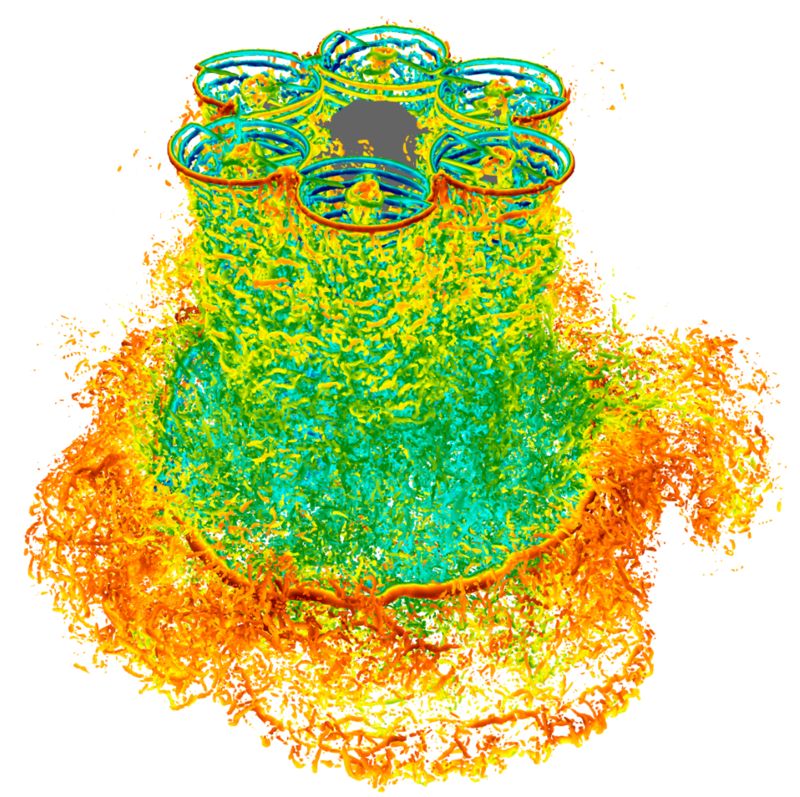High fidelity simulations of moving objects in a turbulent flow using a Cartesian mesh
ARCHER2-eCSE01-06
PI: Dr Sylvain Laizet (Imperial College London)
Co-I(s): Dr Athanasios Giannenas (Imperial College London)
Technical staff: Dr Arash Hamzehloo (Imperial College London)
Subject Area:

Figure 1: Visualisation of vortical structures for a multi-rotor unmanned aerial vehicle in hover.
The development of accurate, efficient and scalable numerical methods capable of simulating arbitrarily complex moving geometries in turbulent flows remains a considerable challenge for the field of Computational Fluid Dynamics (CFD). Furthermore, Fluid-Structure Interaction (FSI) problems where one or more complex solid structures interact and modify the behaviour of the surrounding fluid pose an even greater challenge to the CFD community as the fluid solvers need to also be coupled with structural ones. FSIs are commonly encountered both in nature and in many engineering fields such as aerospace, engine blades, energy (fixed and floating wind turbines, Wave Energy Converters (WECs)) and biomedical engineering (heart valves among others).
While conforming mesh methods (where the mesh conforms to the solid geometry) have been widely used in the past to simulate turbulent flows with complex, the scientific community has recently relied more heavily on non-conforming methods (where the mesh is fixed independently of the solid geometry), due to their ability to avoid meshing issues while also eliminating the need of re-meshing. A popular non-conforming method is the Immersed Boundary Method (IBM) which relies on a fixed mesh and introduces an extra forcing term in the governing equations in order to simulate the presence of the solid object(s) within the computational domain. IBMs allow the use of both Eulerian and Lagrangian coordinates for the solution of the fluid flow and structural response, respectively. Hence, the coupling of the fluid flow and structural solvers becomes fairly straightforward due to the simplicity, flexibility and robustness of IBMs.
In this project, new capabilities have been implemented in the high-order finite-difference framework Xcompact3d so that it can simulate at scale complex moving objects with or without FSI in a single or two-phase turbulent flow. In particular, a CAD interface has been developed to easily insert a complex object inside the computational domain. An original IBM has been developed and validated to reconstruct an artificial flow field inside the immersed object while imposing the appropriate boundary conditions on the boundaries of the object.
Various simulations have been performed with up to 65k cores on ARCHER/ARCHER2 to demonstrate the potential of the new capabilities: the flow around a moving sphere and cylinder, bluff bodies with moving flaps, Vortex Induced Vibrations (VIVs) of 2D and 3D cylinders, a helicopter rotor in hover and in forward flight.
Publications:
- Giannenas, A. E., & Laizet, S., A simple and scalable Immersed Boundary Method for high-fidelity simulations of fixed and moving objects on a Cartesian mesh, Applied Mathematical Modelling, 99, 606-627, 2021
- Hamzehloo, A., Bartholomew, P., & Laizet, S. (2021). Direct numerical simulations of incompressible Rayleigh–Taylor instabilities at low and medium Atwood numbers. Physics of Fluids, 33(5), 054114.
- Giannenas, A. E., Bempedelis N., Schuch F.N. & Laizet, S., A Cartesian immersed boundary method based on 1D flow reconstructions for high-fidelity simulations of incompressible turbulent flows around moving objects, under review in Flow, Turbulence and Combustion, 2022
Information about the code
The software is open source so anyone can use it. It only requires a Fortran compiler combined with an MPI library. https://github.com/xcompact3d/
